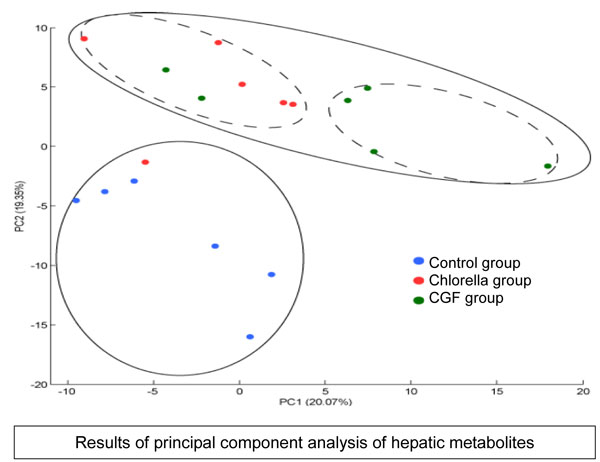- TOP
- List of reports
- Exhaustive Functional Evaluation of Chlorella or CGF Making Use of Metabolite Analysis Technology
Exhaustive Functional Evaluation of Chlorella or CGF Making Use of Metabolite Analysis Technology
【Scientific information】
Research and Development Department, Sun Chlorella Corporation
Exhaustive Functional Evaluation of Chlorella or CGF Making Use of Metabolite Analysis Technology
Presented at the 4th Metabolome Symposium (2009)
Organisms produce various substances uninterruptedly to maintain life activities. Exhaustive analysis of these substances will contribute to better understanding of the entirety of metabolism in the living body. Recently, the technology for analysis of metabolites (metabolome analysis) was established. We report a study recently conducted with the use of such latest technology.
- Objectives
- Chlorella and Chlorella Growth Factor (CGF) are known to have diverse actions, including the effect in improving metabolic syndrome, the effect in improving resistance to stress caused by exercise, immunomodulating effects and so on. To date, no study has been conducted on how intake of these foods modifies metabolites, i.e., which influence these foods have on the whole living body. Under such circumstances, we recently undertook a study in mice to evaluate the extensive actions of Chlorella and CGF exhaustively making us of metabolite analysis.
- Methods
- Ten-week-old male ICR mice were divided into the control group (fed with a basic diet), the Chlorella group (fed with a basic diet supplemented with 5% Chlorella) and the CGF group (fed with a basic diet supplemented with 5% CGF). After one month of rearing, exhaustive analysis of metabolites in plasma and liver was carried out by CE-TOF MS[1] .
- Results
- One-month intake of Chlorella or CGF resulted in differences in many metabolites found in the liver and plasma as compared to the control group. Fig. 1 illustrates part of the results, i.e., the data from principal component analysis designed to detect a tendency in 243 metabolites in the liver [2]. As shown in this figure, the metabolites in the control group were clearly distinguishable from those in the Chlorella group and the CGF group. In other words, it was shown that intake of Chlorella or CGF resulted in differences in various metabolites as compared to the control group. Following intake of Chlorella or CGF, changes occurred in the TCA pathway (producing ATP, a high energy compound), the branched amino acid pathway (known as amino acids for combustion), the nitrogen pathway (excreting nitrogen out of the body) and so on. The living body was thus modified into a state where energy is preferentially acquired from lipid, and antioxidant activity was manifested. It seems likely that such changes in metabolites associated with the change in energy acquisition profile lead to modification of life phenomena which are related in a complex manner with each other. Chlorella is considered to exert extensive actions in this way. The changes were more marked in the CGF group.
- If this approach is combined with thorough analysis of gene expression using DNA microarrays, it will be possible that the actions on the "entire" living body is systematically understood (not possible with the conventional approach designed to evaluate only some particular life phenomena), eventually enabling elucidation of why Chlorella has so extensive actions.

Terminology
- 1) CE-TOF MS
- An abbreviation of capillary electrophoresis・time of flight mass spectroscopy. A technique for isolation of substances at a high voltage with a tube (100 μm or less in diameter) and simultaneous isolation/identification of more ionic substances depending on differences in molecular weight.
- 2) Principal component analysis
- A method of statistical analysis. Like written description of impressions on a book just read, this method briefly summarizes the tendency in data collected. In the figure given above, dots indicate the results of measurement in individual mice. The results of measurement in mice can be shown at a certain location through summarization. If the locations for multiple mice are closer to each other, it means that the results are closer.
Details
- Society meeting:
- 5th Metabolome Symposium
- Title:
- Influence of Chlorella and CGF on Metabolism
- Authors:
- Atsushi Nagashima1), Masaki Fujishima2), Yoshiaki Ohashi1)
- Affiliation:
- 1) Human Metabolome Technologies Inc., 2) Sun Chlorella Corp.





